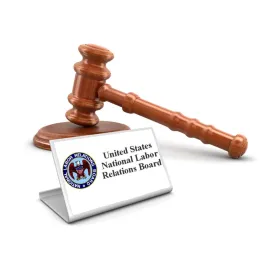The Biden administration has made some early moves that strongly suggest it intends significant changes from the five-member National Labor Relations Board (NLRB) that manufacturers should watch closely.
Currently, the board consist of three Republican members and one Democratic member. The administration replaced Republican board member John Ring as the chairman of the NLRB with member Lauren McFerran. (He remains a sitting member until December 16, 2022.) McFerran is the sole Democratic member on the NLRB. In addition, a vacant seat on the board gives President Joe Biden an immediate opportunity to appoint another Democrat member. Further, he will have an additional seat to fill after Republican member William Emanuel’s term expires on August 27, 2021. Therefore, upon nomination and Senate approval of two (presumably) Democrat members, a new 3-2 Democratic majority will result that likely will begin reversing precedents issued by the prior Republican majority. President Biden also fired NLRB General Counsel Peter Robb and will appoint a new General Counsel. Board actions that follow these appointments will have implications for both union and nonunion manufacturers.
This is particularly important to manufacturers because parts of manufacturing are heavily unionized or may be at risk of unionization due to the large number of employees in single facilities and possible relatively high public profiles, among other factors, that can make them organizing targets.
Union and nonunion manufacturers can watch for a new NLRB’s likely reversal of decisions affecting the lawfulness of many common employment policies as to confidentiality, workplace civility, insubordination, use of company logos and trademarks, media relations, electronic communications, conflict of interests, non-disclosure of proprietary information, and the use of cellphones and cameras in the workplace. Challenges to such policies are more likely to arise during a union organizing attempt. The risk for manufacturers will be significantly increased if Congress passes the Protecting the Right to Organize Act of 2021 (PRO Act). The PRO Act would codify the “micro-unit” rule, establish “quickie election” procedures, and give unions the option to insist upon mail ballots, among other things. A policy found to be unlawful by the NLRB generally could invalidate any representation election in which a manufacturer prevails and result in a re-run election.
Even in the absence of union organizing activity, complying with shifting NLRB rulings will require reviewing workplace policies frequently. Many common policies were subjected to scrutiny by the NLRB during the Obama administration. That NLRB issued decisions finding many ordinary workplace policies infringed upon employees’ rights to engage in concerted, protected activity. For example, the NLRB found that policies prohibiting photography in the workplace (usually designed to protect trade secrets, production techniques, and other proprietary information) unlawfully restricted employees’ protected right to use cameras to document unsafe conditions or evidence to support grievances. In a key 2017 decision, the NLRB adopted a more balanced approach requiring consideration of the employer interests such policies were designed to protect. It is expected that a Democratic majority may revive the pre-2017 reasoning used to invalidate common employment policies. Such decisions by the NLRB could expose the trade secrets, production processes, and other proprietary information particularly important to most manufacturers. Technology and advance processes often give them an edge in the industry.
A new Democratic majority also may reinstate restrictions on manufacturers’ ability to maintain the confidentiality of workplace investigations. If so, manufacturers may be required to prove that the purposes underlying any confidentiality requirement in connection with a workplace investigation were valid and substantial enough to outweigh employee interests in discussing workplace issues. This would impede manufacturers’ ability to investigate harassment and other workplace misconduct effectively.
Further, manufacturers could be compelled by the NLRB to allow employees to use the employer’s electronic and traditional communication systems for personal reasons, including union organizing and protected concerted activity. In its most recent decision on this issue, the NLRB held no such protected right allowed employees to use employer-provided televisions, bulletin boards, copy machines, telephones, or public address systems. A new Democratic board majority could return to precedent, finding employees have a right of access to such communication systems under the National Labor Relations Act (NLRA). This could prove particularly useful to unions at manufacturers with employees who do not have easy means of communicating with coworkers in other shifts or departments.
Manufacturers may consider reviewing their policies in these and other areas now to determine the legality of the current language, not only under current NLRB decisions, but also under prior Obama board decisions. This could help avoid facing unfair labor practice charges seeking to advance new interpretations of the law and the unwanted opportunity to become a test case. On the other hand, a “wait and see” approach will require vigilance to respond to new board decisions that could invalidate existing policies and require disjointed revisions. For manufacturers wanting to maintain compliant policies, the board’s willingness over the decades to change precedent is frustrating. However, a thoughtful approach to reexamining and revising policies generally will allow manufacturers to protect their legitimate interests while avoiding infringement of employee rights under the NLRA.



 />i
/>i
